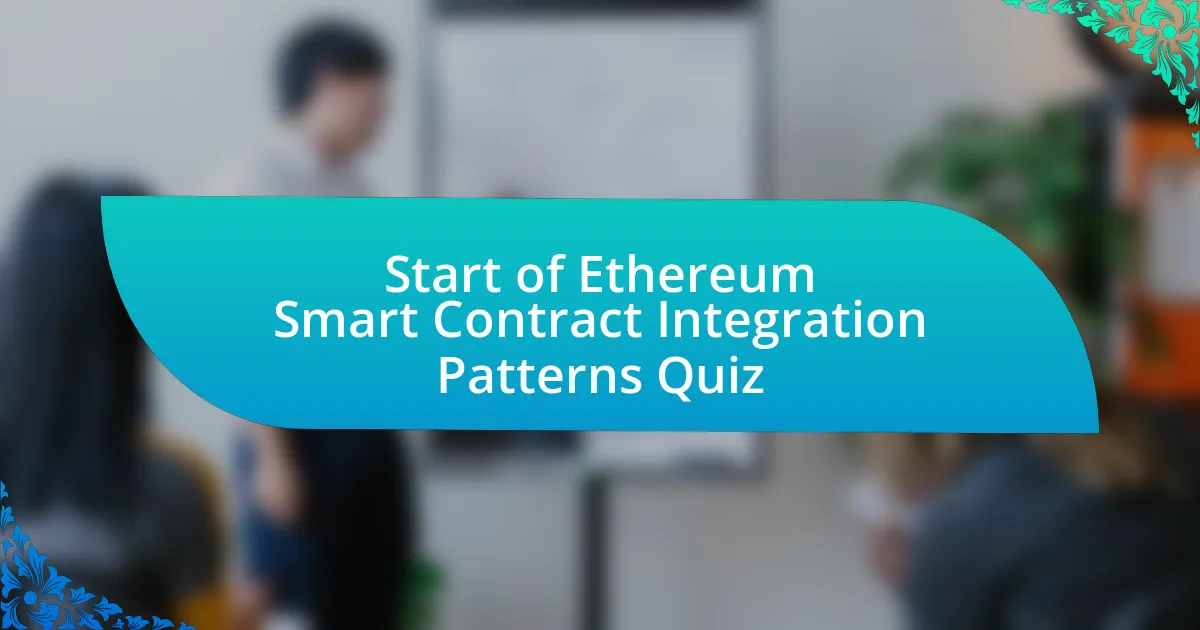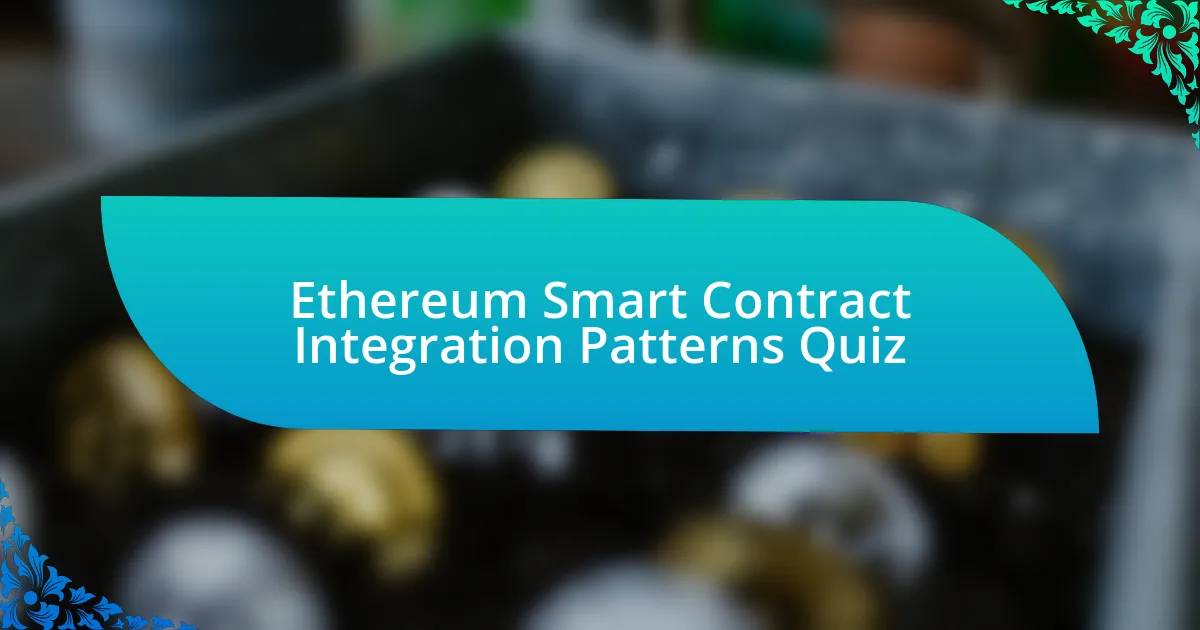
Start of Ethereum Smart Contract Integration Patterns Quiz
1. What is the primary purpose of the Adapter Pattern in Solidity?
- To make contracts compatible with different standards or interfaces.
- To restrict access to certain functions of a contract.
- To manage state transitions within a contract.
- To ensure contract security against vulnerabilities.
2. Which design pattern allows clients to treat individual objects and compositions of objects uniformly?
- The Composite Pattern.
- The Observer Pattern.
- The Builder Pattern.
- The Factory Pattern.
3. What is the purpose of the Strategy Pattern in Solidity?
- To restrict access to contract functions based on user roles.
- To execute different strategies by changing the injected contract.
- To store multiple contracts in a single deployment.
- To enforce strict data validation before execution.
4. What is the Pull Payment Pattern used for in smart contracts?
- To require instant payment confirmations for all transactions.
- To automatically send payments to multiple recipients at once.
- To let the receiver of a payment withdraw the funds if the send operation fails.
- To delegate payment processing to an external service provider.
5. How does the Oracle Pattern solve the problem of external data in smart contracts?
- By using hard-coded values within the contract to avoid external reliance.
- By creating a private channel for all data to prevent external access.
- By utilizing oracles that fetch results from the outside world and return them via a callback function.
- By relying on user inputs only without any external sources.
6. What is the purpose of the Mortal Pattern in smart contracts?
- To restrict access to certain functions in the contract.
- To automate the contract`s execution based on external data.
- To ensure contract interactions are always verified.
- To allow a deployed contract to be destroyed and stop it from operating.
7. Which category of design patterns includes the Pull Payment Pattern?
- Authorization
- Maintenance
- Security
- Action and Control
8. What is the State Machine Pattern used for in smart contracts?
- To restrict access to certain functions in a contract.
- To limit the number of transactions in a given timeframe.
- To allow the retrieval of external data from oracles.
- To manage smart contract transitions through different state transitions over time.
9. Which design pattern is used to manage collections of contracts or data structures?
- The Adapter Pattern
- The Composite Pattern
- The Mortal Pattern
- The Strategy Pattern
10. What is the purpose of the Checks-Effects-Interaction Pattern in smart contracts?
- To ensure that a contract`s effects are properly checked and interacted with.
- To enable off-chain data to alter contract behavior directly.
- To allow multiple contracts to interact with each other seamlessly.
- To improve the gas efficiency of contract functions.
11. Which design pattern is used to maximize the level of security of a smart contract?
- Transaction buffer.
- Interface handler.
- State overlay.
- Security patterns.
12. What is the Emergency Stop Pattern used for in smart contracts?
- To stop the execution of a contract in case of an emergency.
- To enhance the performance of contract transactions.
- To synchronize data across multiple contracts.
- To allow public access to all contract functions.
13. Which category of design patterns includes the Emergency Stop Pattern?
- Security
- Data Management
- Performance
- Maintenance
14. What is the Rate Limit Pattern used for in smart contracts?
- To allow infinite transactions without restrictions.
- To limit the number of transactions that can be executed within a certain time frame.
- To enable only single transactions in a multi-signature wallet.
- To guarantee instant transaction confirmations.
15. Which design pattern is used to manage the lifecycle of a smart contract?
- Security patterns
- Action patterns
- Lifecycle patterns
- Maintenance patterns
16. What is the purpose of the Data Segregation Pattern in smart contracts?
- To limit the number of function calls in a contract.
- To aggregate user data across multiple contracts.
- To segregate data within a contract to improve security and maintainability.
- To host events for contract interactions.
17. Which category of design patterns includes the Data Segregation Pattern?
- Security
- Maintenance
- Lifecycle
- Action and Control
18. What is the purpose of the Contract Register Pattern in smart contracts?
- To limit the number of transactions over time.
- To execute different strategies by changing the injected contract.
- To keep track of all deployed contracts and their versions.
- To manage ownership and control of a contract.
19. Which design pattern is used to manage different versions of a smart contract?
- State Machine Pattern
- Contract Register Pattern
- Oracle Pattern
- Pull Payment Pattern
20. What is the purpose of the Access Restriction Pattern in smart contracts?
- To simplify the code and reduce the size of contracts.
- To restrict access to certain functions or data within a contract.
- To automatically deploy contracts without user input.
- To allow all users to interact freely without limitations.
21. Which category of design patterns includes the Access Restriction Pattern?
- Lifecycle
- Action and Control
- Authorization
- Maintenance
22. What is the purpose of the Ownership Pattern in smart contracts?
- To execute different strategies in a deployment.
- To fetch external data for processing.
- To set transaction limits within a contract.
- To manage ownership and control of a contract.
23. Which design pattern is used to manage ownership and control of a contract?
- Ownership Pattern
- Strategy Pattern
- Access Control Pattern
- Composite Pattern
24. What is the purpose of the Pull Payment Pattern in smart contracts?
- To ensure transactions happen in a specific order.
- To automatically send funds to multiple recipients at once.
- To let the receiver of a payment withdraw the funds if the send operation fails.
- To notify users about transaction statuses in real-time.
25. What is the purpose of the Oracle Pattern in smart contracts?
- To manage user permissions securely.
- To fetch external data and return it via a callback function.
- To execute internal contract functions only.
- To group related contracts together.
26. Which design pattern is used to request external data through an oracle service?
- Adapter Pattern
- Oracle Pattern
- Composite Pattern
- Strategy Pattern
27. Which category of design patterns includes the Mortal Pattern?
- Action and Control
- Authorization
- Lifecycle
- Security
28. What is the purpose of the State Machine Pattern in smart contracts?
- To compile multiple contracts into a single contract.
- To manage smart contract transitions through different state transitions over time.
- To restrict access to certain functions in the contract.
- To enhance the visual representation of smart contract data.
29. Which design pattern is used to manage smart contract transitions through different state transitions over time?
- Oracle Pattern
- Mortal Pattern
- Strategy Pattern
- State Machine Pattern
30. What is the purpose of the Composite Pattern in smart contracts?
- To manage collections of contracts or data structures uniformly.
- To optimize gas fees during contract execution.
- To enable asynchronous operations in smart contracts.
- To restrict user access to certain functions in contracts.

Congratulations! You’ve Successfully Completed the Quiz!
Thank you for participating in our quiz on Ethereum Smart Contract Integration Patterns. We hope you found the experience enjoyable and enlightening. Engaging with questions about smart contracts can deepen your understanding of how decentralized applications operate and communicate on the blockchain. You may have learned about various integration techniques, the importance of security in coding, and the overall architecture that supports Ethereum applications.
As you navigated through the quiz, you likely uncovered key patterns that are essential for effective smart contract development. Integrating these patterns can significantly improve the functionality and reliability of decentralized systems. Whether you focused on external contract interactions, proxy patterns, or event handling, each aspect plays a vital role in building robust Ethereum solutions.
We encourage you to dive deeper into this fascinating topic. Our next section will provide you with additional resources and insights about Ethereum Smart Contract Integration Patterns. This knowledge will enhance your skills and prepare you for practical applications in the blockchain space. Don’t miss the opportunity to expand your understanding and stay ahead in this rapidly evolving field!

Ethereum Smart Contract Integration Patterns
Understanding Ethereum Smart Contracts
Ethereum smart contracts are self-executing contracts with the terms of the agreement directly written into code. They operate on the Ethereum blockchain, allowing decentralized applications (dApps) to function efficiently. These contracts facilitate, verify, and enforce the negotiation or performance of a contract automatically without intermediaries. Their immutable nature ensures that once deployed, they cannot be altered, providing transparency and security.
Common Integration Patterns in Ethereum
Integration patterns in Ethereum refer to the various strategies developers use to connect smart contracts with external applications and services. Common patterns include direct calls to smart contracts, event listening for smart contract emissions, and utilizing oracles for external data inputs. These patterns allow robust interactions between dApps and the blockchain, enhancing functionality and user experience.
Direct Smart Contract Calls
Direct smart contract calls allow one contract to invoke another contract’s functions directly. This integration pattern simplifies communication between contracts and enables seamless transaction processing within the Ethereum network. Developers can define the logic of their applications based on the outcomes of these contracts, ensuring operations occur as intended with minimal complexity.
Event-Driven Architecture in dApps
Event-driven architecture leverages the event logging feature of smart contracts to enhance responsiveness in dApps. Smart contracts emit events when certain state changes occur, allowing external applications to listen and react in real-time. This pattern enables efficient resource usage and encourages a reactive design approach, improving user engagement and application performance.
Using Oracles for External Data Integration
Oracles serve as bridges between the Ethereum blockchain and external data sources. They provide smart contracts with real-time data from outside the blockchain, enabling them to execute based on real-world events. This integration pattern expands the functionality of smart contracts, allowing them to interact with financial markets, weather data, or any API when specific conditions are met, thereby enhancing their utility.
What are Ethereum Smart Contract Integration Patterns?
Ethereum Smart Contract Integration Patterns are established approaches and methodologies used to connect and interact with smart contracts on the Ethereum blockchain. These patterns help developers efficiently structure their applications and enhance interoperability. For example, the Proxy Pattern allows for upgradable contracts, while the Factory Pattern enables the creation of new instances of a contract, driving modular design and scalability in decentralized applications (dApps).
How do developers implement Ethereum Smart Contract Integration Patterns?
Developers implement Ethereum Smart Contract Integration Patterns through coding practices, leveraging smart contract languages like Solidity. They utilize libraries and frameworks, such as OpenZeppelin for security best practices, to aid in integration. For example, by following the Delegated Call Pattern, a developer can ensure that a contract can call another contract while maintaining its context, enabling functionality without losing state.
Where can developers find resources on Ethereum Smart Contract Integration Patterns?
Developers can find resources on Ethereum Smart Contract Integration Patterns in various places, including official documentation on the Ethereum website, GitHub repositories, and online learning platforms like Coursera and Udemy. Additionally, community forums like Stack Exchange and specialized blogs provide practical examples and code snippets to aid understanding.
When should developers consider using specific Ethereum Smart Contract Integration Patterns?
Developers should consider using specific Ethereum Smart Contract Integration Patterns during the early design phase of their application. Choosing the right pattern depends on the project requirements, such as upgradability and modularity. For instance, if a project anticipates needing frequent updates, using the Proxy Pattern is advisable, as it allows the contract code to be upgraded without losing state.
Who benefits from Ethereum Smart Contract Integration Patterns?
Various stakeholders benefit from Ethereum Smart Contract Integration Patterns, including developers, users, and enterprises. Developers gain from enhanced code reusability and structure, which simplifies application development. Users experience increased reliability and security due to best practices. Enterprises benefit from improved scalability and maintainability of their blockchain solutions, optimizing resource allocation.

